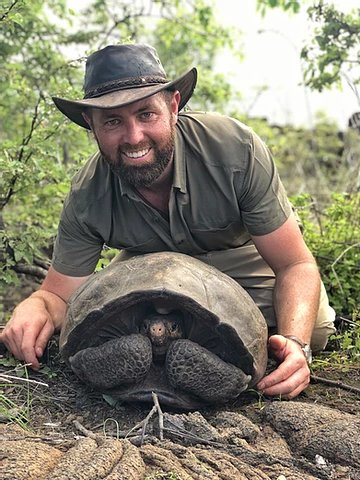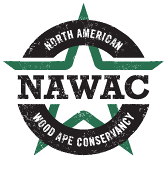Last updated on February 18th, 2025 at 01:28 pm
In a recent interview, Forrest Galante, a well known wildlife biologist and host of Animal Planet’s “Extinct or Alive!”, expresses his opinion on the greater good of a species including the collection of a holotype specimen as it relates to the North American wood ape (sasquatch/bigfoot).
Galante is a graduate from UC Santa Barbara with a degree in biology with a special emphasis in marine biology and herpetology. Since 2018, he has discovered and captured evidence of the existence of two animals once believed to be extinct. In his first discovery, Forrest found trail footage of a Zanzibar leopard, and in 2019 he discovered a female Fernandina Island tortoise, a species that hadn’t been seen for over 100 years. In “Extinct or Alive!” Galante travels the globe searching for animals he believes have wrongfully been deemed extinct.

Photo courtesy of ForrestGalante.com, used by permission.
On the podcast, Bigfoot and Beyond with Cliff and Bobo, Ep. 089 – Forrest Galante, Cliff Barackman and James “Bobo” Fay ask Galante his opinion concerning specimen collection. Below are excerpts from that interview:
[43:34]
CLIFF: As far as taking a holotype goes, I have a little bit of a moral quandary, and I think you do to based on what you said about killing something to prove it’s real. But for sasquatch, if that eventually comes to a head, and bigfoots are proven to be real, no matter how it’s proven to be real they [scientists] are gonna go kill one or several of them to study them. There’s really no other way around it, because that’s how science works. But to get to that spot, to even get the academics out there trying to hunt these things, do you think there’s any other way to prove a species and to collect a holotype for a new novel species that has never been seen [documented] before? Because I can see how photographs would work for something that we knew was real 60 years ago. But for a new/novel unexpected species, like the sasquatch, do you think there’s any other way to get that job done without actually putting a bullet in one?
[44:27]
FORREST: Man, you know I’d love to sit and hear, and say, “Absolutely! Save it! It’s the only way!” But the truth is, the way that our system is set up, there is not – there really isn’t. Now, if you turned up with a foot of one or something like that, sure…or a leg, or an arm that someone hit with a car and that’s what’s left, then sure. But ahead of having that specimen…no. The answer is, no. The way I would handle it if I were targeting these things is, I wouldn’t be out there with a gun, I would study their ecology to the best of my ability, then I would create live traps…and in order to do that you use primitive survival guides, you use engineers, etcetera , etcetera . Which I’ve done, I’ve built these giant crocodile traps and caught big crocs and stuff like that. But…a big croc certainly doesn’t have the intelligence of a bipedal primate! But I think the only way, short of killing one, is to catch one alive and that’s probably even a harder task than shooting one.
[45:26]
CLIFF: Yeah, that’s a bit problematic. I guess that’s why Krantz and Greene, and all the earlier researchers always advocated for killing one; because it’s quick and clean and done, and it’s over and that’s the end of the day. You know?
[46:40]
FORREST: And here’s my two cents on something like that, a relatively unpopular opinion of probably among my type of followers; but, if you’re going to ask me, “Will you go kill an orca to save all the orcas?” We love orcas, killer whales are beautiful, nobody wants to see an orca killed – myself included. But, if you told me that if I was the person that had to kill an orca to save all the orcas, I would do it! I would hate it, I would be miserable, it would be one of the hardest things I would have to do, but for the greater good of the species, I would absolutely do it! And I feel that way about any species. Now if there’s only two of them left and you take that approach then obviously that’s a big problem. And I don’t know what you’re estimated populations are, and everything else, but the point is, if one killed can save a species then it’s a worthwhile kill for the greater good.
[46:28]
BOBO: We figure there’s 3,000 to 10,000 in North America…that’s kind of the guestimate.
[46:33]
FORREST: If that’s the truth, and again I don’t know what systems are in place, but if there were 3,000 of them and you killed one of them, but killing one of them released funding and conservation, and habitat preservation and everything else, then that brought the population (let’s say they are in jeopardy) from 3,000 to that 10,000…then that kill is worth it every time! Right? And again, this is a terribly unpopular opinion, I’m nervous even speaking about it, but it’s how I feel.
[47:03]
CLIFF: It’s also reality, you know? It’s a question, being a biologist like yourself who’s dealing with rare and largely not-well-documented species that are thought to be extinct. That’s a question on your desk and you have to deal with it, and I think it’s a fair position to have no matter what various followers might say. I mean, this is something you have to wrestle with personally.
[47:26]
FORREST: And it doesn’t matter how much you love them, if you want to save them you have to do what it takes.
The complete podcast, “Ep. 089 – Forrest Galante” can be heard here.
The NAWAC shares Galante’s sentiment. The NAWAC’s mission is to ultimately see the wood ape (sasquatch/bigfoot) officially documented by the scientific community at large so that the species can be protected and their habitat conserved.
The Animal Research Review Panel (ARRP) in order to assist Animal Ethics Committees (AECs), in their revised guidelines dated January 2020, “Collection of voucher specimens,” perfectly summarizes the NAWAC’s position:
Species cannot be properly studied or conserved unless there is the ability to accurately recognise and differentiate each species. Incorrect or unresolved identifications can lead to misleading or incomplete conclusions.
“Collection of voucher specimens”, Section 3.1(a)
The ARRP continues:
In some situations, e.g. distinctive species, a non-essential part of the animal such as a hair sample, or a photograph, sound recording or some other non-destructive record may be adequate for identification. These samples however have limited value, especially in the longer term, as they do not offer the range of information as whole body specimens.
There are many species for which these are not valid alternatives. Accurate identifications can only be made if one or more specimens are already available for comparison and examination.
If an animal is thought to represent a new species, a specimen should be taken. Types (the basis for taxonomic descriptions of new taxa) should always be specimens; other kinds of samples are not suitable alternatives.
“Collection of voucher specimens”, Section 4.1(d)
Also note…
Policies and guidelines are developed by the Animal Research Review Panel (ARRP)…to assist researchers and teachers, members of Animal Ethics Committees and the management of scientific institutions…
ARRP policies and guidelines
The NAWAC has adopted the ARRP’s stance concerning non-destructive samples including specimen collection. In order to help describe the wood ape species, the NAWAC attempts to collect many forms of non-destructive records/samples, including photographs, hair and other potential sources of DNA, and even a whole specimen (holotype).
So that the wood ape can be properly documented and in an attempt to adhere and comply to the Animal Research Review Panel’s policies and guidelines, the NAWAC considers itself a pro-science organization.
